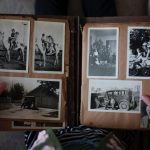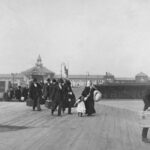In the pursuit of preserving our family history, we embark on a captivating journey that unearths the stories, triumphs, and challenges of our ancestors, shaping our understanding of who we are today. While genealogy traditionally involves meticulous research and documentation, there exists a remarkable synergy between art and the preservation of lineage—the art of genealogy.
The Art of Genealogy delves into the fascinating realm where artistic expression merges with genealogical exploration. This article explores how art can breathe life into the names, dates, and places found in family trees and ancestral records. By harnessing the power of creativity and visual storytelling, we can transform raw data into a vivid tapestry that captures the spirit and essence of our forebears.
Creative Expressions: Using Artistic Mediums to Preserve Ancestral Stories
Art has a unique ability to transcend time, evoking emotions and capturing the essence of the human experience. By harnessing various artistic mediums, we can transform dry facts and figures into visual masterpieces that resonate on a deeply personal level. From paintings and drawings to sculptures and mixed media creations, each artistic form presents an opportunity to illuminate the stories of our past.
One of the most compelling ways to preserve ancestral stories is through visual storytelling. By employing the stroke of a brush, the intricacy of a pencil, or the interplay of colors, we can depict the lives and journeys of our forebears. Portraits of ancestors come to life on canvas, their eyes conveying the wisdom of bygone eras, and their expressions revealing the emotions and experiences they encountered.
Moreover, artistic mediums provide a gateway to exploring the places and settings where our ancestors lived. Through landscape paintings, we can transport ourselves to the rural villages, bustling cities, or expansive homesteads that once framed their lives. With attention to historical details, architecture, and cultural nuances, we can recreate a vivid sense of the environments that shaped their daily existence.
The art of genealogy also extends beyond traditional visual mediums. Photography, for instance, allows us to capture the present-day essence of ancestral locations, documenting the places that hold historical significance. By overlaying archival images with modern-day photographs, we create a visual dialogue between past and present, connecting the dots of our family’s journey across time.
In addition to visual representations, artistic mediums offer unique opportunities for storytelling through other senses. Through music, we can compose melodies that capture the spirit of our lineage, paying homage to the cultural traditions and musical legacies handed down through generations. Through dance and theater, we can embody the narratives of our ancestors, bringing their stories to life with movement and emotion.
By intertwining art and genealogy, we open up a world of possibilities for preserving our family history. Each stroke of a brush, each musical note, each creative endeavor becomes a testament to the lives and experiences of those who came before us. Through creative expressions, we honor their legacy, foster a deeper connection with our roots, and ensure that their stories endure for generations to come.
Visualizing Heritage: Creating Family Trees and Lineage Charts
Within the vast realm of genealogical exploration, one powerful and visually compelling method of preserving our family history emerges—creating family trees and lineage charts.
Family trees serve as a cornerstone of genealogical research, offering a clear and concise depiction of our familial connections across generations. These visual representations not only provide a structured overview but also bring order to the complexities of our heritage. Through carefully constructed family trees, we gain a comprehensive understanding of our lineage and the interwoven stories of our ancestors.
The creation of a family tree is both a meticulous task and an artistic endeavor. It requires skillful organization, attention to detail, and an eye for design. Each branch represents a distinct bloodline, while each leaf symbolizes an individual, forming a tapestry of interconnected lives.
Modern technology has granted us access to a wide array of tools and software specifically designed for constructing family trees. These resources streamline the process, allowing us to digitally arrange the names, dates, and relationships of our ancestors in an aesthetically pleasing and informative manner. With customizable templates and intuitive interfaces, we can personalize our family trees, adding photographs, historical documents, and anecdotes that further illuminate the stories behind each name.
Lineage charts provide another artistic avenue for visualizing our heritage. Going beyond the traditional family tree structure, lineage charts showcase ancestral lines, tracing our lineage back through time. These charts offer a captivating snapshot of our ancestral roots, highlighting pivotal individuals and the flow of lineage through the ages.
When creating family trees and lineage charts, we have the opportunity to infuse artistry into the design. From selecting elegant fonts and colors to incorporating meaningful symbols and motifs, we can enhance the visual appeal while reflecting the essence of our family’s history. Through careful consideration of layout and composition, we can craft visually stunning representations that engage and captivate those who explore our ancestral narratives.
Beyond their aesthetic allure, family trees and lineage charts become invaluable heirlooms. They serve as enduring legacies, passed down through generations, ensuring that our family’s stories remain alive and cherished. By sharing these visual representations with our relatives, we foster a deeper sense of connection and spark conversations that unearth forgotten tales and reveal new insights into our shared heritage.
Portraits of the Past: Painting or Drawing Ancestors’ Likenesses
The act of painting or drawing our ancestors‘ likenesses transcends mere representation. It becomes a deeply personal and emotional journey, a quest to immortalize the faces that have shaped our heritage. With every brushstroke or pencil line, we breathe life into faded photographs and distant memories, transporting our ancestors from the past into the present.
Through art, we gain a deeper understanding of our ancestors as individuals with unique stories and personalities. A portrait can convey more than just physical features; it can encapsulate the character, spirit, and resilience that define our lineage. The process of carefully studying archival photographs, deciphering their expressions, and translating them onto canvas or paper allows us to forge a profound connection with our forebears.
The creation of ancestral portraits requires both technical skill and emotional intuition. Artists must capture the subtleties of facial features, master the play of light and shadow, and evoke a sense of depth and realism. However, beyond technical proficiency lies the ability to breathe life into the portrait, to infuse it with the emotions and stories that lie beneath the surface.
As we embark on the artistic journey of portraying our ancestors, we may encounter challenges and gaps in historical knowledge. In such instances, artistic interpretation plays a significant role, allowing us to fill in the blanks with empathy, research, and an understanding of the cultural context in which our ancestors lived. Through artistic license, we can create portraits that not only depict physical appearances but also offer glimpses into the lives they led and the world they inhabited.
The impact of ancestral portraits extends beyond the aesthetic realm. They serve as powerful reminders of our roots, tangible connections to the past that anchor us in our present. Displayed in our homes or shared with family members, these portraits become cherished heirlooms, evoking conversations, and passing on the stories and legacies of our ancestors to future generations.
Evocative Landscapes: Capturing Ancestral Places Through Art
Ancestral landscapes carry the weight of history, embodying the essence of the places our ancestors called home. Whether it be the rolling hills of a countryside, the bustling streets of a city, or the serene shores of a distant coastline, these settings provide a backdrop to the stories and experiences of our forebears.
Through the medium of art, we have the power to transport ourselves to these evocative landscapes, capturing their spirit and beauty. Paintings, drawings, and other artistic renditions allow us to visually recreate the places that hold significance in our family history. The stroke of a brush or the lines on a canvas can bring to life the architectural nuances, the natural features, and the cultural elements that defined the world of our ancestors.
The process of capturing ancestral landscapes through art requires a blend of observation, research, and creative interpretation. By delving into historical records, photographs, and personal accounts, we gain insights into the settings in which our ancestors lived. Attention to detail, from the distinct architectural styles to the colors and textures of the natural surroundings, enables us to create authentic and captivating representations.
In addition to traditional visual mediums, advancements in technology have opened new avenues for capturing ancestral landscapes. Digital art, photography, and even virtual reality can transport us to the very locations our ancestors once inhabited. With the click of a camera or the stroke of a stylus, we can document the present-day state of ancestral places, juxtaposing them with historical references to illuminate the passage of time and evoke a sense of continuity.
Capturing ancestral landscapes through art serves a dual purpose. It not only allows us to visually engage with the places that shaped our family history but also provides a means of preservation. By immortalizing these landscapes in artistic form, we ensure that the memory and significance of these places endure for generations to come.
Through exhibitions, displays, or sharing our artwork with family and community, we can kindle conversations and foster a deeper understanding of our ancestral landscapes. By exploring these environments through art, we forge a connection between our present selves and the places that once held the footsteps of our ancestors.
Artifacts and Memorabilia: Infusing Personal Touches into Artwork
Artifacts and memorabilia hold a unique power—they are tangible links to our ancestors, encapsulating their experiences, passions, and personal stories. These objects may include letters, diaries, jewelry, clothing, tools, or any item that has been passed down through the generations. Each artifact is a gateway to the past, offering glimpses into the lives and personalities of our forebears.
Incorporating these meaningful artifacts into our artwork creates a harmonious fusion of the past and the present. By weaving these physical remnants into the artistic tapestry, we transcend the boundaries of time, bridging the gap between generations and embodying the spirit of our ancestors.
One approach to incorporating artifacts into artwork is through mixed media creations. By combining painting, collage, and assemblage techniques, we can merge historical photographs, handwritten letters, and small mementos onto a single canvas or artwork. These mixed media pieces serve as visual collages that celebrate the diverse facets of our family’s history, giving voice to the voices that have come before us.
Photography also offers a powerful medium for infusing artifacts into our artistic endeavors. By staging and photographing artifacts alongside ancestral portraits or in relevant settings, we create visually compelling compositions that pay homage to our family’s heritage. The juxtaposition of past and present, of artifacts and artwork, tells a story that transcends time and captures the essence of our lineage.
Another creative approach is to use artifacts as inspiration for standalone art pieces. For instance, we can take a cherished heirloom, such as a piece of jewelry or a family crest, and create intricate illustrations or detailed sculptures that embody its symbolism and significance. These artistic interpretations become visual tributes, honoring the objects that have been passed down through generations.
By infusing our artwork with artifacts and memorabilia, we create multidimensional pieces that speak to the heart and soul of our family history. These creations become more than just artistic expressions—they become vessels of memory, preserving the stories, emotions, and connections that flow through our lineage.
Sharing Legacies: Art as a Means of Connecting with Future Generations
As we reach the final subheading of our exploration into the art of genealogy, we arrive at a crucial aspect of this creative endeavor—sharing our legacies with future generations. Subheading 8, “Sharing Legacies: Art as a Means of Connecting with Future Generations,” delves into the profound impact art can have in preserving and passing on our family history to those who will walk in our footsteps.
Art has the remarkable ability to transcend time and language, serving as a universal language that speaks to the heart and sparks imagination. By infusing our family history with artistic expressions, we create bridges between generations, fostering a deep connection and understanding that transcends the passage of time.
One powerful way to share our legacies through art is by creating family history albums or illustrated narratives. These artistic compilations bring together ancestral stories, photographs, documents, and artwork into a cohesive and visually captivating format. These albums become cherished keepsakes, allowing future generations to delve into the rich tapestry of their family’s past and discover their own place within the continuum of history.
Artistic collaborations with younger family members can also be a meaningful way to pass on our genealogical knowledge. By involving children or grandchildren in art projects that explore their family history, we ignite their curiosity and engage their creativity. Together, we can create artwork that represents their understanding and interpretation of their ancestral roots, nurturing a sense of belonging and pride in their heritage.
Furthermore, art exhibitions, family gatherings, or community events can serve as platforms to showcase our artistic creations and share our family history with a broader audience. By presenting our artwork alongside narratives and historical context, we invite others to join in the exploration of our genealogical journey. These shared experiences create opportunities for dialogue, the exchange of stories, and the weaving together of diverse perspectives into a collective tapestry of human history.
In the digital age, technology offers novel ways to share our artistic expressions and family history. Online platforms, social media, and digital storytelling tools enable us to reach a global audience and connect with relatives and descendants scattered across the globe. Through virtual exhibitions, interactive websites, or digital archives, we can ensure that our artistic legacy and family history are accessible to future generations.
Image Source:
- Photo by Philippe Tinembart: instant images





